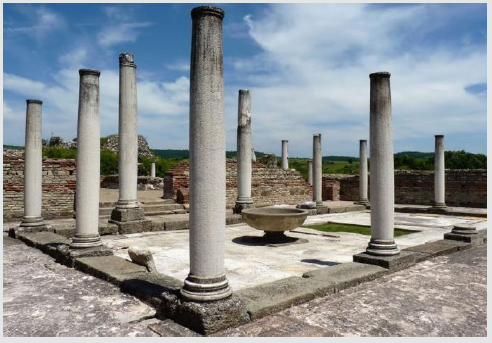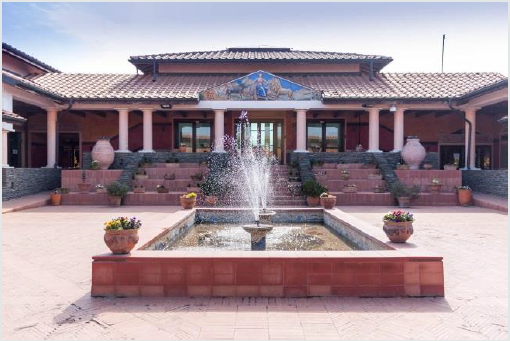
Lupine Publishers Group
Lupine Publishers
Menu
ISSN: 2690-5752
Mini review(ISSN: 2690-5752) 
the-short-review-of-tourist-valorized-archeological-sites-in-serbia.ID.000169 Volume 3 - Issue 4
Radmila Jovanović*
- Faculty of Geography, University of Belgrade, Belgrade, Serbia
Received: February 03, 2021 Published: February 18, 2021
Corresponding author:Radmila Jovanović, Faculty of Geography, University of Belgrade, Belgrade, Serbia
DOI: 10.32474/JAAS.2021.03.000169
Abstract
The space in Serbia is showed a lot of numbers of archeological sites, which is the result of rich culture and history. This space present the point of connection and separation different civilizations, interest, strategies and politics. Insufficient investment of local government, presentations, education of local residents, non-recognition of the state interest maked difference and uneven tourism development in Serbia. The one of example are archeological sites which haven’t equal tourist values. On the other hand, we have the good example of invesment, presentation sites, building visitor centres, virtual presentation, tecnological inovation, interpretation with multimedia and an unforgettable experience of tourists – Archeological park ‘’Viminacium’’.
Keywords: Archeological Sites; Tourism; Valorization; Serbia
Introduction
Republic of Serbia is located in southeast part of Europe.
The history of Serbia through of centuries was passed wars and
turbulent processes. Before Slavs settled this region, on this area
had lived different civilizations: Dardanians, Romans, Dacians,
Huns. All civilizations had left the deep trace in the history of this
region.
From Ottoman period, Serbia has a lot of heritage of archeological
sites. Generally, all archeological sites dating from different historic
period: Paleolithic, Mesolithic, Neolithic, Eneolithic, Copper Age,
Bronze Age, Iron Age, Roman period, Middle Ages - New Century,
etc.
Archaeological sites have long been a part of heritage and its
display, certainly before the use of the term “heritage” and the
formal study of tourism [1]. In recent years, there has been an
increasingly noticeable increase in the threat to the archaeological
heritage in Serbia, which can be seen on several levels [2].
Materials and Methods
The aim of this short article is presented uneven relation of
archaeological sites in Serbia, and show the small number sites
which have tourist valorization and arrangement.
Also, to indicate the importance of archaeological sites and
point out the directions of its tourist development. Development
tourism in places with archeological sites, has the potential to bring
local or descendant communities financial gain [3]. Tourism and
Heritage Management are part of the economic movement [4].
The data for research were collected in the field, internet
analysis of tourist sites (Tourist Organization of Serbia, sites of local
tourist organization, Trip Advisor, etc.) and literature.
Serbia is country, where is clear felt unevenness in territorial
tourism development. In Serbia have 117 [5] archeolgical sites
registered by Institute for the Protection of Cultural Monuments
of Serbia. Therefrom, 65 is registred in Autonomy Province Kosovo
and Metohija , and 52 in Central Serbia and Autonomy Province
Vojvodina. However, all of them don’t have equal tourist values.
Some archeological sites are recognizable symbol as a part of the
World and Serbian cultural heritage, while the others unfairly
neglected and unnoticed. The conservation of archeological sites
over the centuries is a responsibility of our society, in order to pass
on to future generations [6].
Of total number (117) which are registered in Serbia, 15 are
included in tourism offer of local municipalities. Those are: Ancient Taurunum, Vinča and Ancient Singidunum in Belgrade; Gamzigrad
(Zaječar); Viminacium (Kostolac); Mediana, Fortress and Ancient
thermal baths on Fortess in Niš; Timacum Minus (Knjaževac);
Remisiana (Bela Palanka); Lepenski vir (Donji Milanovac); Pontes
(Kladovo); Lederata (Veliko Gradište); Karataš (Kladovo) and Devil
‘s town (Kuršumlija). The most important are:
1. Gamzigrad (Felix Romuliana) – the only archeological site from Serbia who is on the UNESCO list of protect. The remnants of old and younger fortification were undiscovered. In the north part of the fortress remnants of a Church, Palace 1, Palace 2 and a big building with corridor were undiscovered, and in the south part remnants of a Church, Horeum, Tribunal and Thearme [7] (Figure 1).
2. Viminacium - the most orderly archeological park in Serbia, with all elements for full tourist experience (good example of invesment, with visitor centers, virtual presentation, technological innovation, interpretation with multimedia, etc.). The archeological site Viminacijum is located near the mouth of river Mlava to Danube, at the today’s Kostolac, some 12 km from the city Pozarevac. It was a largest urban settlement in the Upper Mesia and a signifi cant military center [8] (Figure 2).
3. Vinča and Lepenski vir - the most oldest arranged
archeological sites in Serbia for tourist visit in Serbia.
4. Sirmium - the archeological site Sirmium located in
Sremska Mitrovica, is an antic city built in the 1st century
(Figure 3).
The construction of ‘’Visitor Centers’’ is one of effective ways to
present this valuable heritage. In Serbia have several archeological
sites that are very interesting for the development of cultural
tourism: Viminacium, Sirmium and Gamzigrad [9].
Other remaining number of archeological sites (102) are
noticed that the tourist fit-out insufficient and should be raised
to a higher level for the purpose of tourism development. The
environments at certain archeological sites have a good quality
and can come to empower the spaces for tourist activities. Some
of archeological sites have not been researched in detail, and their
significance weren’t determined [10].
Conclusion
The aim of develop archeological sites need to do better allocation of funds, greater promotion, getting to know a larger number of residents, the commitment of the competent authorities to their affirmation, an attempt to advance through international cooperation and projects and inclusion in the tourist offer. The culture and heritage tourism has a great significance in the modern world in travel. Therefore, the historical worth of the heritage and culture require preservation and conservation in their usual form.
References
- Matero FG (2008) Heritage, conservation, and archaeology: An introduction. Heritage, Conservation, and Archaeology 1-5.
- Црнобрња А (2019) Подизање свести о значајуархеолошког наслеђа, Реализација пројекта Српског археолошког друштва. Модерна конзервација 7: 19-31.
- Pacifico D, Melissa M (2012) Archaeological sites, modern communities, and tourism. Annals of Tourism Research 39(3): 1588-1611.
- Guimarães GM, Anjos FA, Farias DSE, Arnold Junior M (2018) Archaeological heritage management and tourism development: Actions and proposals. Revista Brasileirade Pesquisa em Turismo 12(3): 47-80.
- http://spomenicikulture.mi.sanu.ac.rs
- Vicente R, Lagomarsino S, Ferreira TM, Cattari S, Mendes da Silva JAR (2018) Cultural Heritage Monuments and Historical Buildings: Conservation Works and Structural Retrofitting. Strengthening and Retrofitting of Existing Structures 25-57.
- Nikolic M (2010) The possibilitis of protection and presentation of urban complex by example of archeological site Sirmium, Proc. of the 5th Regional conference on integrative protection – integrative conservation and sustainable development, Banja Luka, Serbia.
- Драгојловић А и др (2007) Споменичко наслеђе Србије. Београд: Републички Завод за заштиту споменика културе.
- Nikolić M (2011) Visitors’ centers at archeological sites in serbia as an imput for sustainable development of the country. Institute for Research and Design in Economy, Belgrade, Serbia Journal of Applied Engineering Science 9(1): 253-258.
- Mikić Ž (1989) Prilog antropološkom upoznavanju neolita u Srbiji. Glasnik Srpskog arheološkog druš Faculty of Philosophy, Univestity of Belgrade, Serbia 5: 18-26.

Top Editors
-

Mark E Smith
Bio chemistry
University of Texas Medical Branch, USA -

Lawrence A Presley
Department of Criminal Justice
Liberty University, USA -

Thomas W Miller
Department of Psychiatry
University of Kentucky, USA -

Gjumrakch Aliev
Department of Medicine
Gally International Biomedical Research & Consulting LLC, USA -

Christopher Bryant
Department of Urbanisation and Agricultural
Montreal university, USA -

Robert William Frare
Oral & Maxillofacial Pathology
New York University, USA -

Rudolph Modesto Navari
Gastroenterology and Hepatology
University of Alabama, UK -

Andrew Hague
Department of Medicine
Universities of Bradford, UK -

George Gregory Buttigieg
Maltese College of Obstetrics and Gynaecology, Europe -

Chen-Hsiung Yeh
Oncology
Circulogene Theranostics, England -
.png)
Emilio Bucio-Carrillo
Radiation Chemistry
National University of Mexico, USA -
.jpg)
Casey J Grenier
Analytical Chemistry
Wentworth Institute of Technology, USA -
Hany Atalah
Minimally Invasive Surgery
Mercer University school of Medicine, USA -

Abu-Hussein Muhamad
Pediatric Dentistry
University of Athens , Greece

The annual scholar awards from Lupine Publishers honor a selected number Read More...






